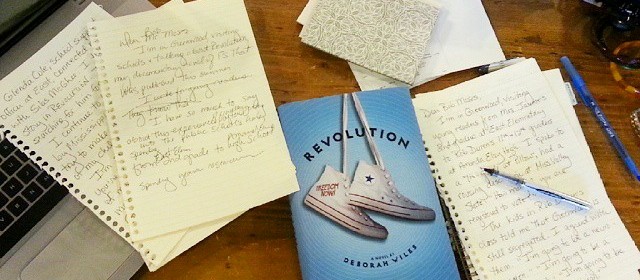"Ruby Lavender really started here," I told them, "in a little town in Mississippi, at the turn of the century. That's Miss Eula, in the white blouse, standing with her mother and father and little brother." Gasps in the audience!
 |
"Here's the pink palace," I told them. I spent many a childhood summer in this house, with Miss Eula. In this photo, she's standing on the sidewalk next to her mother. We all called her mother -- my great-grandmother -- "Nanny." I do believe that's Nanny's husband, Pa, sitting on the front porch. I never knew him, as he died before I was born, but he used to lead the singing school every summer, and he purchased the Stamps-Baxter songbooks for everyone in town, every year. People came to visit with their money and left with a songbook.
"Ruby Lavender began here, too," I told my third graders, "with Miss Eula's children, including a little girl who loved a chicken named Rosebud -- my Aunt Beth -- and a big brother who loved that little girl.
That brother grew up to be a dashing Air Force second lieutenant...
... who, on a blind date, met a beautiful Mississippi girl, a stenographer at Brookley Field in Mobile. They fell madly in love, and life was suddenly lived in color:
Which is when I came along, their first child.
And no matter where we lived (well, other than the three years we were in Hawaii), we found a way to get to Mississippi to visit our grandmother every summer. We visited our grandmother, her mother, the great aunts and uncles, the cousins... we honored them and they loved us, and I became attached to them and to the place of my father's birth.
The stories I heard over and over through the years as I sat on the front porch surrounded by kin became part of my blood, my mythology, my lore. And Ruby Lavender was born from my longing for that place and time. Longing for those people who knew me. Longing for that love, for that wackiness, for that messy glory.
Today so many of my best beloveds are gone. The house is dilapidated and empty. The town is full of ghosts. But the stories remain.
The stories go on, and it is the stories that give us our history, that make us human, that define us. It's the stories, told and lived by those amazing, flawed, daring, loving human beings, that have shaped my life.
How amazing to think that a book I wrote from those stories mixed with my own experience has the potential to touch three-thousand nine-year-olds in a town in North Carolina, all of whom seem to love Miss Eula as much as I did.
And how astonishing to think that I now have those stories to pass on to my new granddaughter, Abbie, whom we welcomed into the world on April first, just before midnight. What stories will she have to tell? What stories about her own grandmother? Grandmothers.
In Love, Ruby Lavender, Miss Eula tells Ruby, over and again, "Life goes on." Yes, it does.
Welcome to the world, Abigail Grace. Congratulations, Jason and Stephanie. And, likewise, congratulations to the kinfolks: to Miss Eula, Nanny, Pa, Dad, Mom, Aunt Beth, and to all you aunts and uncles and cousins and loved ones who are here, as well as all who are long gone away. Our family grows. You are not forgotten.
Through our stories, you will live forever.








